Scenario Response - Tom - CHCDIS005: Disability Support Assessment
VerifiedAdded on 2022/11/09
|7
|1932
|122
Practical Assignment
AI Summary
This assignment presents a student's response to a scenario involving Tom, a young man with spinal injuries, focusing on person-centered service responses. The student, in the role of a Disability Support Worker, analyzes initial case notes and addresses Tom's needs, including communication strategies to engage him and his mother. The assessment involves completing and adapting a support plan based on provided information and progress updates. The student demonstrates an understanding of legal and ethical considerations, relevant networks, and services, showcasing their ability to provide appropriate support. The assignment requires the student to identify Tom's goals, barriers, and potential strategies to achieve them, demonstrating a comprehensive approach to disability support.
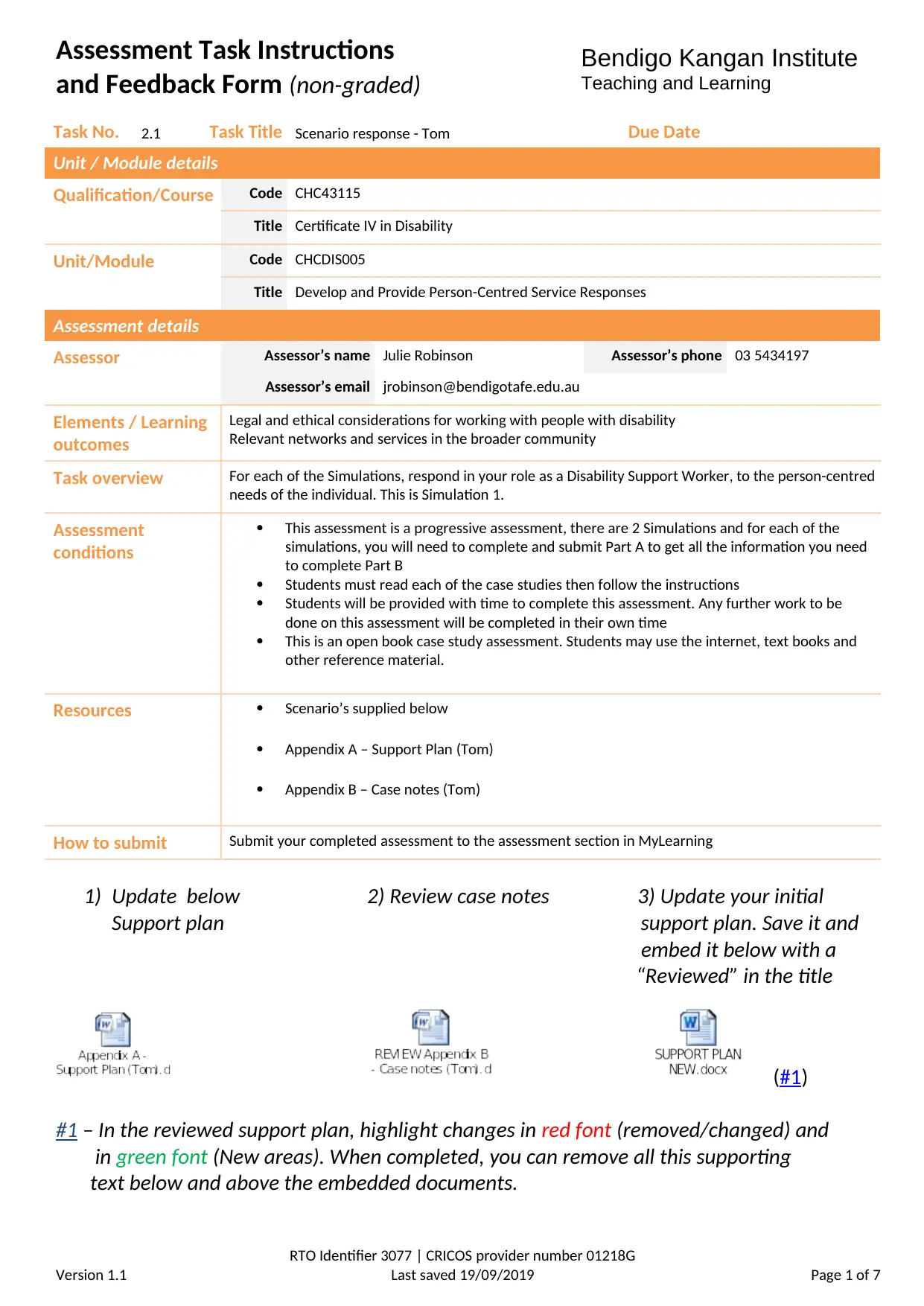
Assessment Task Instructions
and Feedback Form (non-graded)
Bendigo Kangan Institute
Teaching and Learning
Task No. 2.1 Task Title Scenario response - Tom Due Date
Unit / Module details
Qualification/Course Code CHC43115
Title Certificate IV in Disability
Unit/Module Code CHCDIS005
Title Develop and Provide Person-Centred Service Responses
Assessment details
Assessor Assessor’s name Julie Robinson Assessor’s phone 03 5434197
Assessor’s email jrobinson@bendigotafe.edu.au
Elements / Learning
outcomes
Legal and ethical considerations for working with people with disability
Relevant networks and services in the broader community
Task overview For each of the Simulations, respond in your role as a Disability Support Worker, to the person-centred
needs of the individual. This is Simulation 1.
Assessment
conditions
This assessment is a progressive assessment, there are 2 Simulations and for each of the
simulations, you will need to complete and submit Part A to get all the information you need
to complete Part B
Students must read each of the case studies then follow the instructions
Students will be provided with time to complete this assessment. Any further work to be
done on this assessment will be completed in their own time
This is an open book case study assessment. Students may use the internet, text books and
other reference material.
Resources Scenario’s supplied below
Appendix A – Support Plan (Tom)
Appendix B – Case notes (Tom)
How to submit Submit your completed assessment to the assessment section in MyLearning
1) Update below 2) Review case notes 3) Update your initial
Support plan support plan. Save it and
embed it below with a
“Reviewed” in the title
(#1)
#1 – In the reviewed support plan, highlight changes in red font (removed/changed) and
in green font (New areas). When completed, you can remove all this supporting
text below and above the embedded documents.
RTO Identifier 3077 | CRICOS provider number 01218G
Version 1.1 Last saved 19/09/2019 Page 1 of 7
and Feedback Form (non-graded)
Bendigo Kangan Institute
Teaching and Learning
Task No. 2.1 Task Title Scenario response - Tom Due Date
Unit / Module details
Qualification/Course Code CHC43115
Title Certificate IV in Disability
Unit/Module Code CHCDIS005
Title Develop and Provide Person-Centred Service Responses
Assessment details
Assessor Assessor’s name Julie Robinson Assessor’s phone 03 5434197
Assessor’s email jrobinson@bendigotafe.edu.au
Elements / Learning
outcomes
Legal and ethical considerations for working with people with disability
Relevant networks and services in the broader community
Task overview For each of the Simulations, respond in your role as a Disability Support Worker, to the person-centred
needs of the individual. This is Simulation 1.
Assessment
conditions
This assessment is a progressive assessment, there are 2 Simulations and for each of the
simulations, you will need to complete and submit Part A to get all the information you need
to complete Part B
Students must read each of the case studies then follow the instructions
Students will be provided with time to complete this assessment. Any further work to be
done on this assessment will be completed in their own time
This is an open book case study assessment. Students may use the internet, text books and
other reference material.
Resources Scenario’s supplied below
Appendix A – Support Plan (Tom)
Appendix B – Case notes (Tom)
How to submit Submit your completed assessment to the assessment section in MyLearning
1) Update below 2) Review case notes 3) Update your initial
Support plan support plan. Save it and
embed it below with a
“Reviewed” in the title
(#1)
#1 – In the reviewed support plan, highlight changes in red font (removed/changed) and
in green font (New areas). When completed, you can remove all this supporting
text below and above the embedded documents.
RTO Identifier 3077 | CRICOS provider number 01218G
Version 1.1 Last saved 19/09/2019 Page 1 of 7
Paraphrase This Document
Need a fresh take? Get an instant paraphrase of this document with our AI Paraphraser
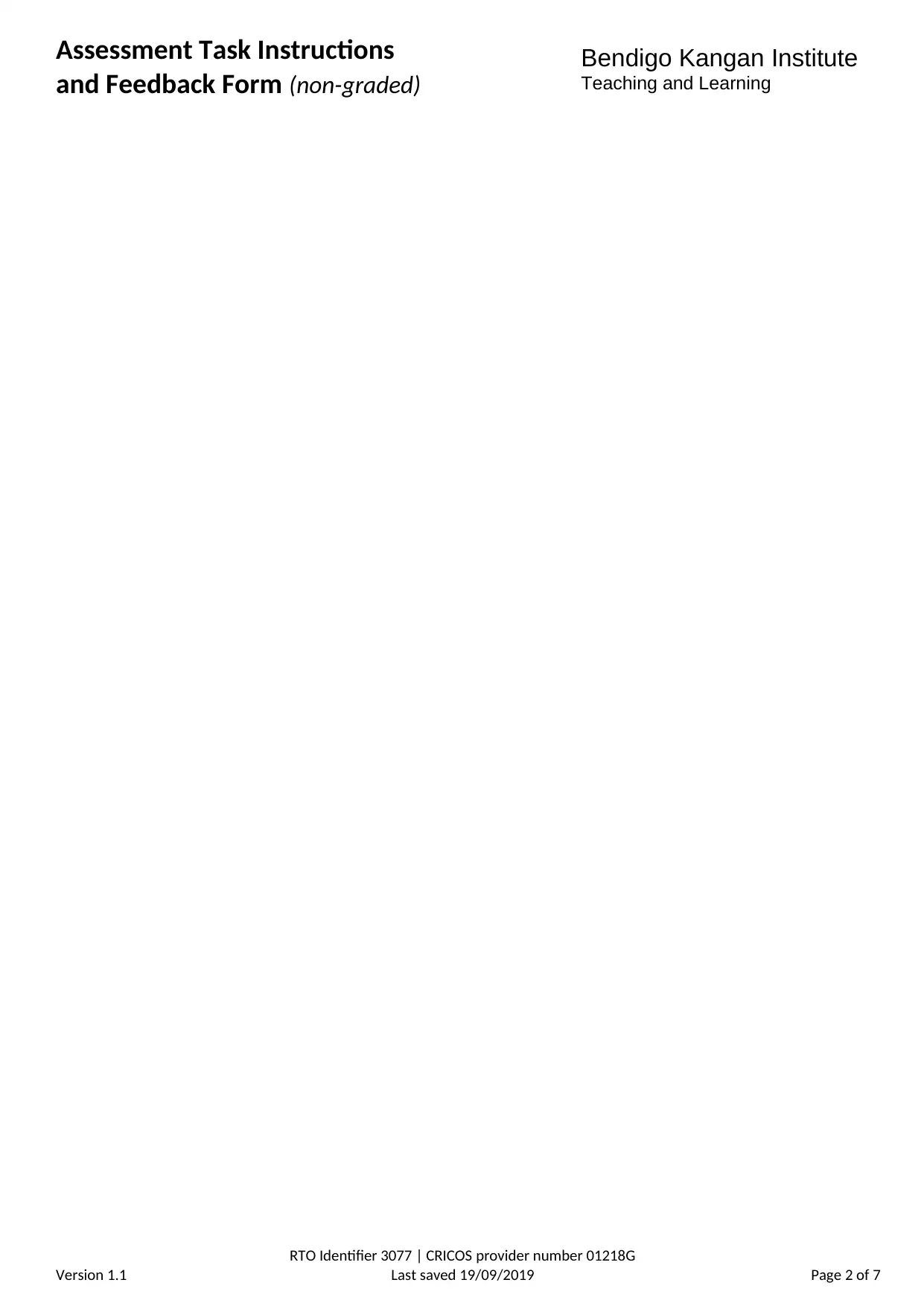
Assessment Task Instructions
and Feedback Form (non-graded)
Bendigo Kangan Institute
Teaching and Learning
RTO Identifier 3077 | CRICOS provider number 01218G
Version 1.1 Last saved 19/09/2019 Page 2 of 7
and Feedback Form (non-graded)
Bendigo Kangan Institute
Teaching and Learning
RTO Identifier 3077 | CRICOS provider number 01218G
Version 1.1 Last saved 19/09/2019 Page 2 of 7
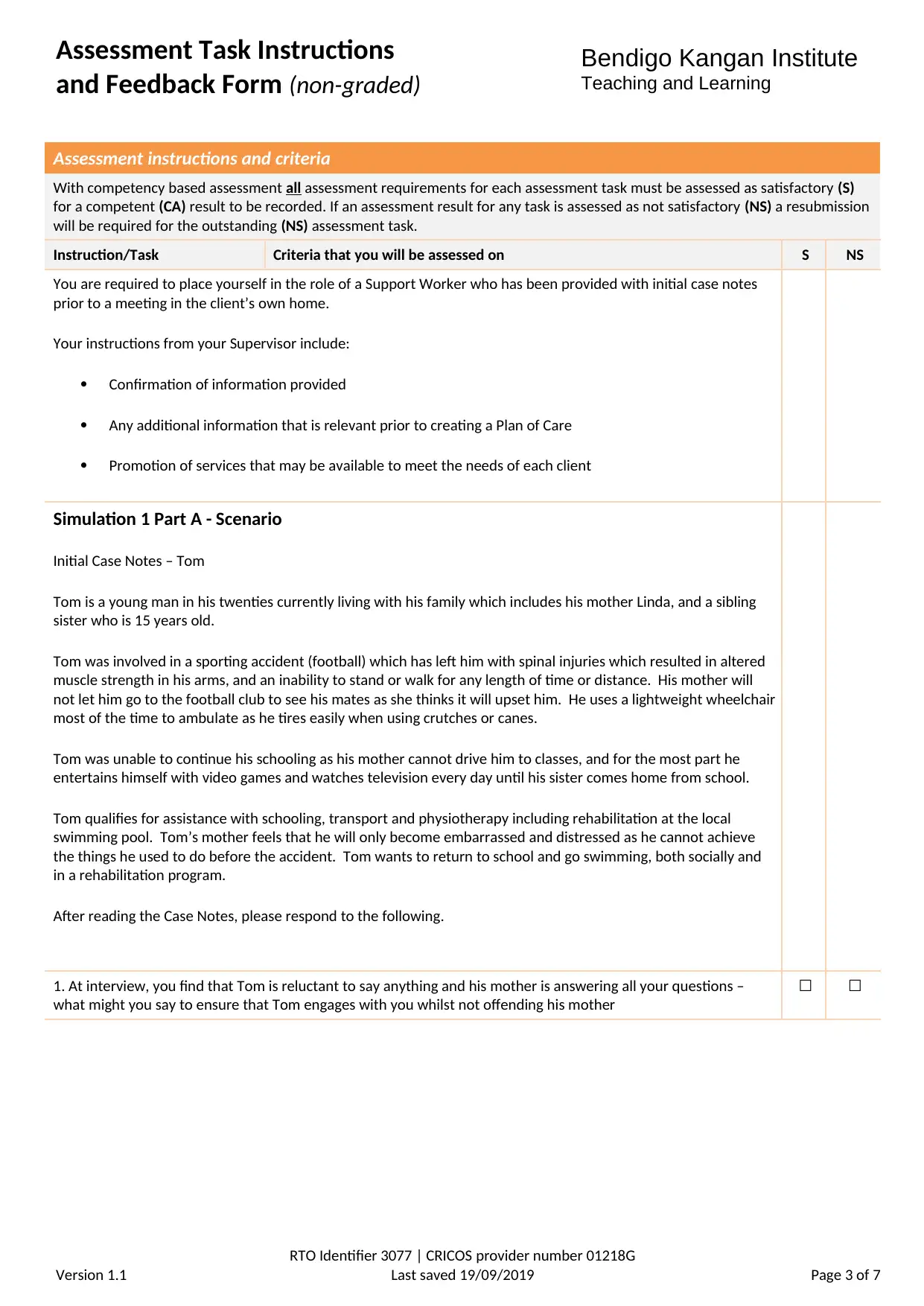
Assessment Task Instructions
and Feedback Form (non-graded)
Bendigo Kangan Institute
Teaching and Learning
Assessment instructions and criteria
With competency based assessment all assessment requirements for each assessment task must be assessed as satisfactory (S)
for a competent (CA) result to be recorded. If an assessment result for any task is assessed as not satisfactory (NS) a resubmission
will be required for the outstanding (NS) assessment task.
Instruction/Task Criteria that you will be assessed on S NS
You are required to place yourself in the role of a Support Worker who has been provided with initial case notes
prior to a meeting in the client’s own home.
Your instructions from your Supervisor include:
Confirmation of information provided
Any additional information that is relevant prior to creating a Plan of Care
Promotion of services that may be available to meet the needs of each client
Simulation 1 Part A - Scenario
Initial Case Notes – Tom
Tom is a young man in his twenties currently living with his family which includes his mother Linda, and a sibling
sister who is 15 years old.
Tom was involved in a sporting accident (football) which has left him with spinal injuries which resulted in altered
muscle strength in his arms, and an inability to stand or walk for any length of time or distance. His mother will
not let him go to the football club to see his mates as she thinks it will upset him. He uses a lightweight wheelchair
most of the time to ambulate as he tires easily when using crutches or canes.
Tom was unable to continue his schooling as his mother cannot drive him to classes, and for the most part he
entertains himself with video games and watches television every day until his sister comes home from school.
Tom qualifies for assistance with schooling, transport and physiotherapy including rehabilitation at the local
swimming pool. Tom’s mother feels that he will only become embarrassed and distressed as he cannot achieve
the things he used to do before the accident. Tom wants to return to school and go swimming, both socially and
in a rehabilitation program.
After reading the Case Notes, please respond to the following.
1. At interview, you find that Tom is reluctant to say anything and his mother is answering all your questions –
what might you say to ensure that Tom engages with you whilst not offending his mother
☐ ☐
RTO Identifier 3077 | CRICOS provider number 01218G
Version 1.1 Last saved 19/09/2019 Page 3 of 7
and Feedback Form (non-graded)
Bendigo Kangan Institute
Teaching and Learning
Assessment instructions and criteria
With competency based assessment all assessment requirements for each assessment task must be assessed as satisfactory (S)
for a competent (CA) result to be recorded. If an assessment result for any task is assessed as not satisfactory (NS) a resubmission
will be required for the outstanding (NS) assessment task.
Instruction/Task Criteria that you will be assessed on S NS
You are required to place yourself in the role of a Support Worker who has been provided with initial case notes
prior to a meeting in the client’s own home.
Your instructions from your Supervisor include:
Confirmation of information provided
Any additional information that is relevant prior to creating a Plan of Care
Promotion of services that may be available to meet the needs of each client
Simulation 1 Part A - Scenario
Initial Case Notes – Tom
Tom is a young man in his twenties currently living with his family which includes his mother Linda, and a sibling
sister who is 15 years old.
Tom was involved in a sporting accident (football) which has left him with spinal injuries which resulted in altered
muscle strength in his arms, and an inability to stand or walk for any length of time or distance. His mother will
not let him go to the football club to see his mates as she thinks it will upset him. He uses a lightweight wheelchair
most of the time to ambulate as he tires easily when using crutches or canes.
Tom was unable to continue his schooling as his mother cannot drive him to classes, and for the most part he
entertains himself with video games and watches television every day until his sister comes home from school.
Tom qualifies for assistance with schooling, transport and physiotherapy including rehabilitation at the local
swimming pool. Tom’s mother feels that he will only become embarrassed and distressed as he cannot achieve
the things he used to do before the accident. Tom wants to return to school and go swimming, both socially and
in a rehabilitation program.
After reading the Case Notes, please respond to the following.
1. At interview, you find that Tom is reluctant to say anything and his mother is answering all your questions –
what might you say to ensure that Tom engages with you whilst not offending his mother
☐ ☐
RTO Identifier 3077 | CRICOS provider number 01218G
Version 1.1 Last saved 19/09/2019 Page 3 of 7
⊘ This is a preview!⊘
Do you want full access?
Subscribe today to unlock all pages.

Trusted by 1+ million students worldwide
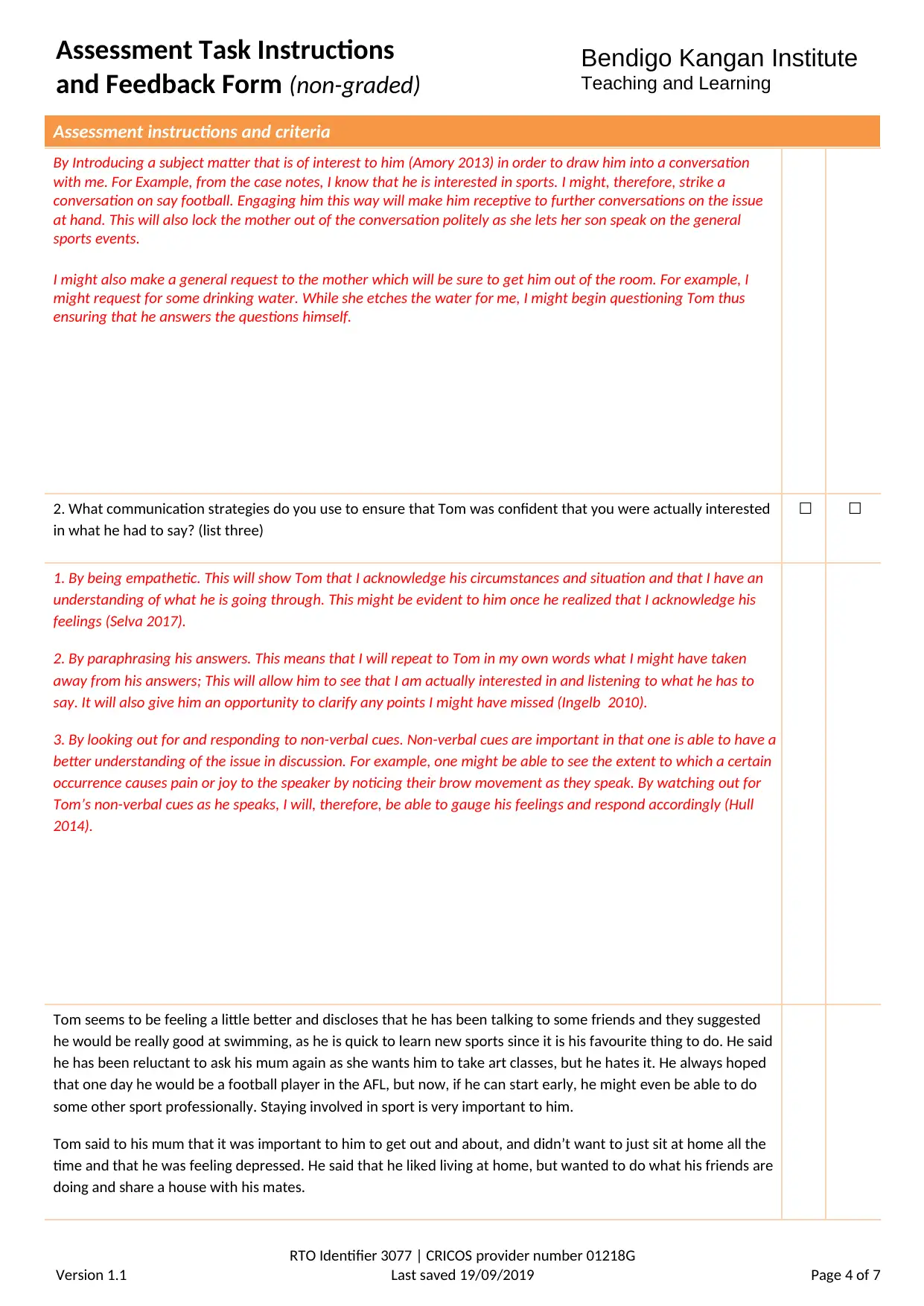
Assessment Task Instructions
and Feedback Form (non-graded)
Bendigo Kangan Institute
Teaching and Learning
Assessment instructions and criteria
By Introducing a subject matter that is of interest to him (Amory 2013) in order to draw him into a conversation
with me. For Example, from the case notes, I know that he is interested in sports. I might, therefore, strike a
conversation on say football. Engaging him this way will make him receptive to further conversations on the issue
at hand. This will also lock the mother out of the conversation politely as she lets her son speak on the general
sports events.
I might also make a general request to the mother which will be sure to get him out of the room. For example, I
might request for some drinking water. While she etches the water for me, I might begin questioning Tom thus
ensuring that he answers the questions himself.
2. What communication strategies do you use to ensure that Tom was confident that you were actually interested
in what he had to say? (list three)
☐ ☐
1. By being empathetic. This will show Tom that I acknowledge his circumstances and situation and that I have an
understanding of what he is going through. This might be evident to him once he realized that I acknowledge his
feelings (Selva 2017).
2. By paraphrasing his answers. This means that I will repeat to Tom in my own words what I might have taken
away from his answers; This will allow him to see that I am actually interested in and listening to what he has to
say. It will also give him an opportunity to clarify any points I might have missed (Ingelb 2010).
3. By looking out for and responding to non-verbal cues. Non-verbal cues are important in that one is able to have a
better understanding of the issue in discussion. For example, one might be able to see the extent to which a certain
occurrence causes pain or joy to the speaker by noticing their brow movement as they speak. By watching out for
Tom’s non-verbal cues as he speaks, I will, therefore, be able to gauge his feelings and respond accordingly (Hull
2014).
Tom seems to be feeling a little better and discloses that he has been talking to some friends and they suggested
he would be really good at swimming, as he is quick to learn new sports since it is his favourite thing to do. He said
he has been reluctant to ask his mum again as she wants him to take art classes, but he hates it. He always hoped
that one day he would be a football player in the AFL, but now, if he can start early, he might even be able to do
some other sport professionally. Staying involved in sport is very important to him.
Tom said to his mum that it was important to him to get out and about, and didn’t want to just sit at home all the
time and that he was feeling depressed. He said that he liked living at home, but wanted to do what his friends are
doing and share a house with his mates.
RTO Identifier 3077 | CRICOS provider number 01218G
Version 1.1 Last saved 19/09/2019 Page 4 of 7
and Feedback Form (non-graded)
Bendigo Kangan Institute
Teaching and Learning
Assessment instructions and criteria
By Introducing a subject matter that is of interest to him (Amory 2013) in order to draw him into a conversation
with me. For Example, from the case notes, I know that he is interested in sports. I might, therefore, strike a
conversation on say football. Engaging him this way will make him receptive to further conversations on the issue
at hand. This will also lock the mother out of the conversation politely as she lets her son speak on the general
sports events.
I might also make a general request to the mother which will be sure to get him out of the room. For example, I
might request for some drinking water. While she etches the water for me, I might begin questioning Tom thus
ensuring that he answers the questions himself.
2. What communication strategies do you use to ensure that Tom was confident that you were actually interested
in what he had to say? (list three)
☐ ☐
1. By being empathetic. This will show Tom that I acknowledge his circumstances and situation and that I have an
understanding of what he is going through. This might be evident to him once he realized that I acknowledge his
feelings (Selva 2017).
2. By paraphrasing his answers. This means that I will repeat to Tom in my own words what I might have taken
away from his answers; This will allow him to see that I am actually interested in and listening to what he has to
say. It will also give him an opportunity to clarify any points I might have missed (Ingelb 2010).
3. By looking out for and responding to non-verbal cues. Non-verbal cues are important in that one is able to have a
better understanding of the issue in discussion. For example, one might be able to see the extent to which a certain
occurrence causes pain or joy to the speaker by noticing their brow movement as they speak. By watching out for
Tom’s non-verbal cues as he speaks, I will, therefore, be able to gauge his feelings and respond accordingly (Hull
2014).
Tom seems to be feeling a little better and discloses that he has been talking to some friends and they suggested
he would be really good at swimming, as he is quick to learn new sports since it is his favourite thing to do. He said
he has been reluctant to ask his mum again as she wants him to take art classes, but he hates it. He always hoped
that one day he would be a football player in the AFL, but now, if he can start early, he might even be able to do
some other sport professionally. Staying involved in sport is very important to him.
Tom said to his mum that it was important to him to get out and about, and didn’t want to just sit at home all the
time and that he was feeling depressed. He said that he liked living at home, but wanted to do what his friends are
doing and share a house with his mates.
RTO Identifier 3077 | CRICOS provider number 01218G
Version 1.1 Last saved 19/09/2019 Page 4 of 7
Paraphrase This Document
Need a fresh take? Get an instant paraphrase of this document with our AI Paraphraser
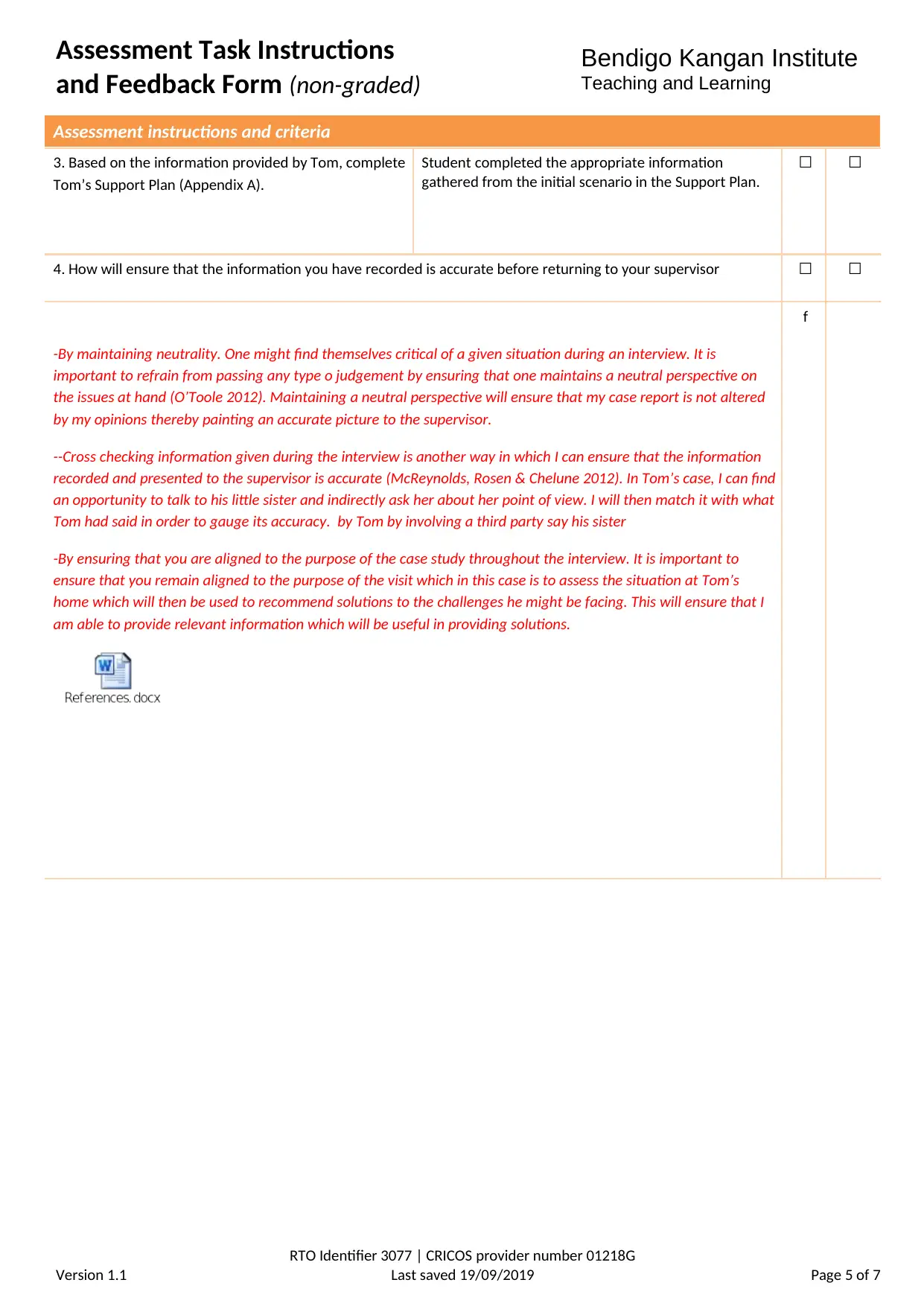
Assessment Task Instructions
and Feedback Form (non-graded)
Bendigo Kangan Institute
Teaching and Learning
Assessment instructions and criteria
3. Based on the information provided by Tom, complete
Tom’s Support Plan (Appendix A).
Student completed the appropriate information
gathered from the initial scenario in the Support Plan.
☐ ☐
4. How will ensure that the information you have recorded is accurate before returning to your supervisor ☐ ☐
-By maintaining neutrality. One might find themselves critical of a given situation during an interview. It is
important to refrain from passing any type o judgement by ensuring that one maintains a neutral perspective on
the issues at hand (O’Toole 2012). Maintaining a neutral perspective will ensure that my case report is not altered
by my opinions thereby painting an accurate picture to the supervisor.
--Cross checking information given during the interview is another way in which I can ensure that the information
recorded and presented to the supervisor is accurate (McReynolds, Rosen & Chelune 2012). In Tom’s case, I can find
an opportunity to talk to his little sister and indirectly ask her about her point of view. I will then match it with what
Tom had said in order to gauge its accuracy. by Tom by involving a third party say his sister
-By ensuring that you are aligned to the purpose of the case study throughout the interview. It is important to
ensure that you remain aligned to the purpose of the visit which in this case is to assess the situation at Tom’s
home which will then be used to recommend solutions to the challenges he might be facing. This will ensure that I
am able to provide relevant information which will be useful in providing solutions.
f
RTO Identifier 3077 | CRICOS provider number 01218G
Version 1.1 Last saved 19/09/2019 Page 5 of 7
and Feedback Form (non-graded)
Bendigo Kangan Institute
Teaching and Learning
Assessment instructions and criteria
3. Based on the information provided by Tom, complete
Tom’s Support Plan (Appendix A).
Student completed the appropriate information
gathered from the initial scenario in the Support Plan.
☐ ☐
4. How will ensure that the information you have recorded is accurate before returning to your supervisor ☐ ☐
-By maintaining neutrality. One might find themselves critical of a given situation during an interview. It is
important to refrain from passing any type o judgement by ensuring that one maintains a neutral perspective on
the issues at hand (O’Toole 2012). Maintaining a neutral perspective will ensure that my case report is not altered
by my opinions thereby painting an accurate picture to the supervisor.
--Cross checking information given during the interview is another way in which I can ensure that the information
recorded and presented to the supervisor is accurate (McReynolds, Rosen & Chelune 2012). In Tom’s case, I can find
an opportunity to talk to his little sister and indirectly ask her about her point of view. I will then match it with what
Tom had said in order to gauge its accuracy. by Tom by involving a third party say his sister
-By ensuring that you are aligned to the purpose of the case study throughout the interview. It is important to
ensure that you remain aligned to the purpose of the visit which in this case is to assess the situation at Tom’s
home which will then be used to recommend solutions to the challenges he might be facing. This will ensure that I
am able to provide relevant information which will be useful in providing solutions.
f
RTO Identifier 3077 | CRICOS provider number 01218G
Version 1.1 Last saved 19/09/2019 Page 5 of 7
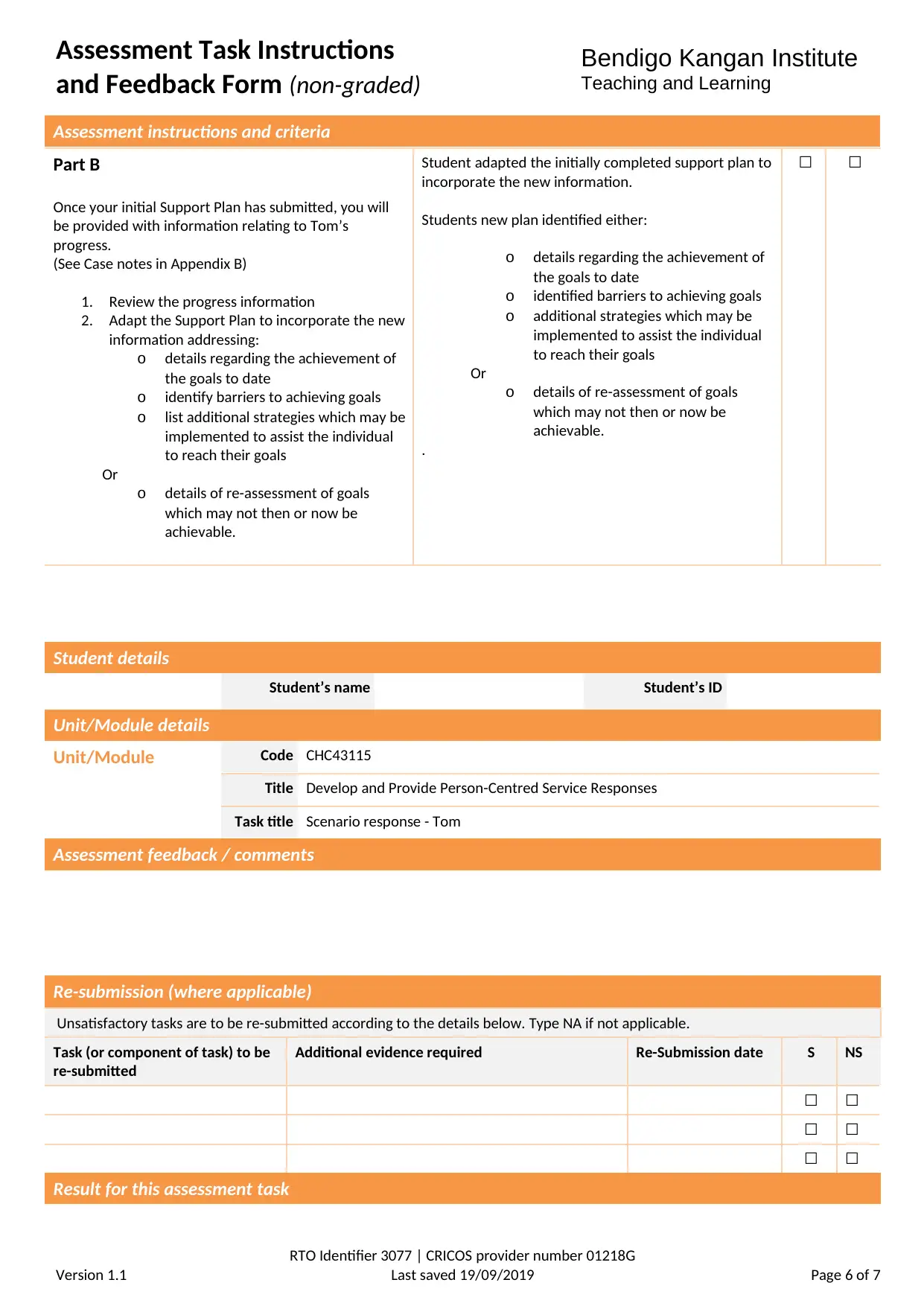
Assessment Task Instructions
and Feedback Form (non-graded)
Bendigo Kangan Institute
Teaching and Learning
Assessment instructions and criteria
Part B
Once your initial Support Plan has submitted, you will
be provided with information relating to Tom’s
progress.
(See Case notes in Appendix B)
1. Review the progress information
2. Adapt the Support Plan to incorporate the new
information addressing:
o details regarding the achievement of
the goals to date
o identify barriers to achieving goals
o list additional strategies which may be
implemented to assist the individual
to reach their goals
Or
o details of re-assessment of goals
which may not then or now be
achievable.
Student adapted the initially completed support plan to
incorporate the new information.
Students new plan identified either:
o details regarding the achievement of
the goals to date
o identified barriers to achieving goals
o additional strategies which may be
implemented to assist the individual
to reach their goals
Or
o details of re-assessment of goals
which may not then or now be
achievable.
.
☐ ☐
Student details
Student’s name Student’s ID
Unit/Module details
Unit/Module Code CHC43115
Title Develop and Provide Person-Centred Service Responses
Task title Scenario response - Tom
Assessment feedback / comments
Re-submission (where applicable)
Unsatisfactory tasks are to be re-submitted according to the details below. Type NA if not applicable.
Task (or component of task) to be
re-submitted
Additional evidence required Re-Submission date S NS
☐ ☐
☐ ☐
☐ ☐
Result for this assessment task
RTO Identifier 3077 | CRICOS provider number 01218G
Version 1.1 Last saved 19/09/2019 Page 6 of 7
and Feedback Form (non-graded)
Bendigo Kangan Institute
Teaching and Learning
Assessment instructions and criteria
Part B
Once your initial Support Plan has submitted, you will
be provided with information relating to Tom’s
progress.
(See Case notes in Appendix B)
1. Review the progress information
2. Adapt the Support Plan to incorporate the new
information addressing:
o details regarding the achievement of
the goals to date
o identify barriers to achieving goals
o list additional strategies which may be
implemented to assist the individual
to reach their goals
Or
o details of re-assessment of goals
which may not then or now be
achievable.
Student adapted the initially completed support plan to
incorporate the new information.
Students new plan identified either:
o details regarding the achievement of
the goals to date
o identified barriers to achieving goals
o additional strategies which may be
implemented to assist the individual
to reach their goals
Or
o details of re-assessment of goals
which may not then or now be
achievable.
.
☐ ☐
Student details
Student’s name Student’s ID
Unit/Module details
Unit/Module Code CHC43115
Title Develop and Provide Person-Centred Service Responses
Task title Scenario response - Tom
Assessment feedback / comments
Re-submission (where applicable)
Unsatisfactory tasks are to be re-submitted according to the details below. Type NA if not applicable.
Task (or component of task) to be
re-submitted
Additional evidence required Re-Submission date S NS
☐ ☐
☐ ☐
☐ ☐
Result for this assessment task
RTO Identifier 3077 | CRICOS provider number 01218G
Version 1.1 Last saved 19/09/2019 Page 6 of 7
⊘ This is a preview!⊘
Do you want full access?
Subscribe today to unlock all pages.

Trusted by 1+ million students worldwide
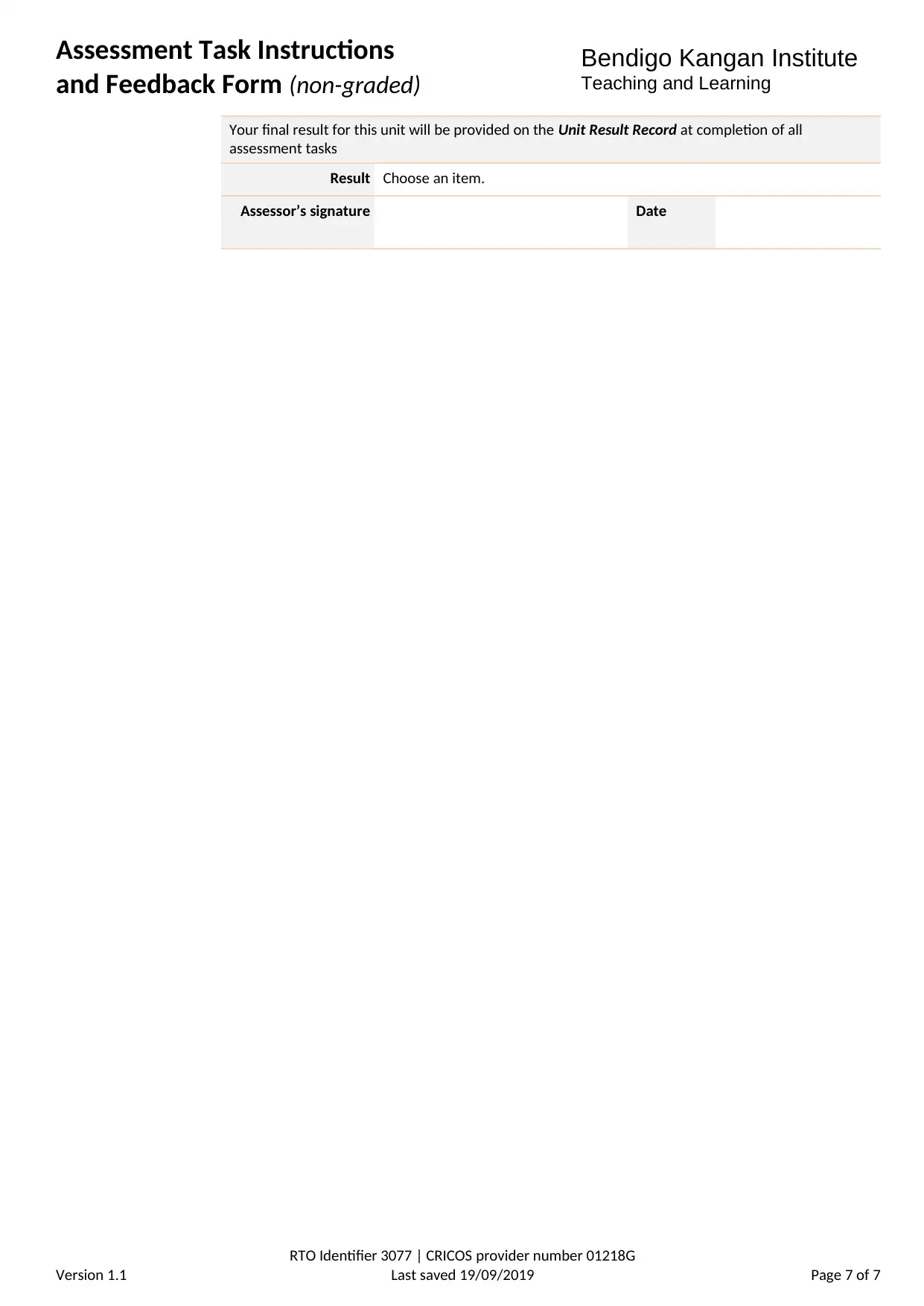
Assessment Task Instructions
and Feedback Form (non-graded)
Bendigo Kangan Institute
Teaching and Learning
Your final result for this unit will be provided on the Unit Result Record at completion of all
assessment tasks
Result Choose an item.
Assessor’s signature Date
RTO Identifier 3077 | CRICOS provider number 01218G
Version 1.1 Last saved 19/09/2019 Page 7 of 7
and Feedback Form (non-graded)
Bendigo Kangan Institute
Teaching and Learning
Your final result for this unit will be provided on the Unit Result Record at completion of all
assessment tasks
Result Choose an item.
Assessor’s signature Date
RTO Identifier 3077 | CRICOS provider number 01218G
Version 1.1 Last saved 19/09/2019 Page 7 of 7
1 out of 7
Related Documents
Your All-in-One AI-Powered Toolkit for Academic Success.
+13062052269
info@desklib.com
Available 24*7 on WhatsApp / Email
![[object Object]](/_next/static/media/star-bottom.7253800d.svg)
Unlock your academic potential
Copyright © 2020–2025 A2Z Services. All Rights Reserved. Developed and managed by ZUCOL.





